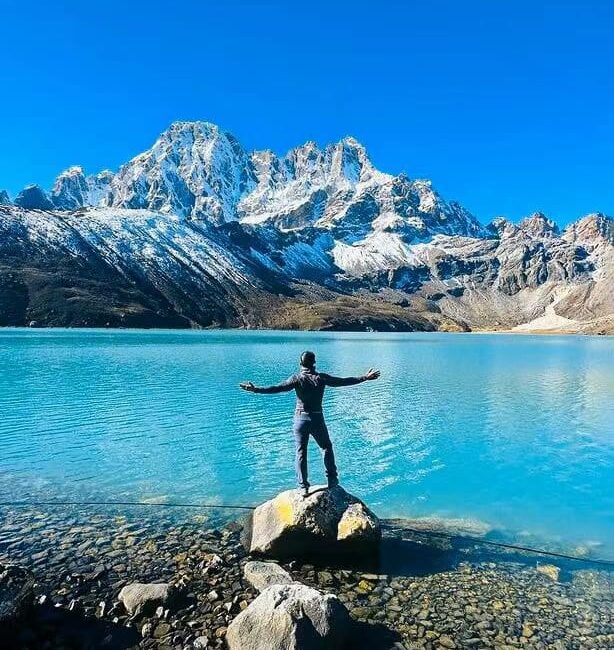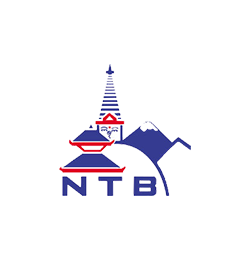
Introduction
Trekking in the Himalayas is an experience that goes beyond normal traveling; it’s a journey into the heart of nature’s grandeur. In the Himalayas, every step you take reveals breathtaking vistas and cultural treasures. Two countries Nepal and India have been popular destinations for adventures from around the globe to explore the Himalayan trails. Being blessed with magnificent Himalayan ranges to the north, has created marvelous trekking trails in both countries. However, throughout the decade the question of Which country is best for hiking lingers in every adventurer’s mind.
In this comparative exploration, we’ll look into the essentials for trekking in both countries by examining the landscapes, cultural richness, infrastructure, and overall experience to determine which country stands out to provide the ultimate trekking experience. Even though these two countries are neighbors, the overall experience varies vastly as each country’s culture, landscapes, and way of life differ.
1. Landscape and Scenery:
– Nepal:
Nepal is home to eight of the world’s ten highest peaks, including Mount Everest (8,849 meters). It has a diverse landscape that ranges from lush lowland plains to towering snow-capped peaks. The diversity of the landscape has created numerous trekking trails in Nepal. Trails around Annapurna and the Everest region are renowned for their spectacular panoramas. These trails are covered with lush rhododendron forests, terraced fields, and rugged mountain passes.
Famous treks such as Annapurna Circuit and Everest Base Camp in Nepal have a flow of about 40,000 people each year. Trekkers determined to conquer these trails get rewarded with unparalleled views of the towering peaks and dramatic landscapes. On the other hand, Nepal is also home to hidden gems, which remain fairly silent yet equally stunning. Trails like Manaslu Circuit and Langtang Valley are great trails for a peaceful retreat in the Himalayas.
– India:
India’s Himalayan range spans several states, each offering a unique trekking experience. The verdant valleys, alpine meadows, and cascading rivers characterize the Indian Himalayas. Some of the best trails in India are found in Himachal Pradesh, Uttarakhand, Jammu and Kashmir. These places showcase the biodiversity of India, with options ranging from gentle walks to challenging high-altitude treks.
Popular treks like The Valley of Flowers trek in Uttarakhand, and the Markha Valley trek in Ladakh are some of the best treks India has to offer. With each step taken towards these trails, you get blown by the stunning scenery and vibrant floral displays with great mountain vistas.
Comparison:
Both Nepal and India have awe-inspiring landscapes, each beautiful in their way. While the landscapes of Nepal provide you with unparalleled views of the towering peaks, India offers a diverse terrain, including lush forests and alpine meadows. While each country provides a magnificent trekking experience, Nepal has much more to offer with its world-famous trails, and hidden gems that are still to be discovered. For a trekker, who seeks a highly customizable trek, the chances of finding one that aligns with his needs are higher in Nepal.
Moreover, whether your next trek should be in Nepal or India ultimately depends on the specific scenery and experiences desired by the trekker.
2. Cultural Richness:
– Nepal:
The cultural diversity of Nepal is another reason that adds to a magnificent trekking experience. Trekking in Nepal offers encounters with ethnic communities such as the Sherpas, Gurungs, and Tamangs, who have inhabited the region for centuries. Each region in Nepal is inhabited by a particular community, such as the Everest region by Sherpas and the Annapurna region by Gurungs. Each of these communities has its unique set of traditions, cultures, and practices that make every adventure unique.
Along the trails, trekkers get to visit traditional villages, numerous monasteries, and ancient stupas. As each day passes in the Himalayas you gain insight into Nepal’s unique blend of Hinduism and Buddhism. When you choose the right time, you get to experience rare customs and practices in these regions. For that, a reliable trekking agency like White Hill Adventure promises a magnificent experience in the Himalayas.
– India:
The Himalayas of India are home to a variety of cultures, with influences from Tibetan Buddhism, Hinduism, and indigenous traditions. As you trek in India, you pass through remote villages that are inhabited by diverse ethnic groups such as Gaddis, Bhotias, and Kinnauris. India is well known for its sacred sites, temples, and ancient monasteries, adding spiritual significance to your trek. Popular places like Kailash Mansarovar hold great cultural significance in Hinduism and Buddhism.
For a deeper cultural experience in India, you can plan for festivals like Hemis Festival in Ladakh and Kullu Dussehra in Himachal Pradesh which offer a great insight into the local customs and traditions. Moreover, experiencing these festivals requires a perfectly planned itinerary, which with White Hill Adventure is easily accessible.
Comparison:
Both Nepal and India are no less when it comes to cultural richness. Trekkers can engage with indigenous communities and witness old traditions that have been passed down for centuries. In Nepal, you get a chance to connect with the locals on a deeper level as you spend nights in teahouses. Whereas India offers a much more diverse cultural landscape that provides a broader perspective on the Himalayan way of living.
Nepal and India are both Hindu countries with partial Buddhist influence, this creates a similarity in most of the traditions. However, they both have their hint of uniqueness offering a completely different yet somewhat familiar experience.
3. Infrastructure and Facilities:
– Nepal:
Nepal’s trekking infrastructure has evolved significantly over the years. Most of the trails in Nepal have well-established trails, teahouses, and support services for trekkers. Moreover, on famous trekking trails like Everest Base Camp and Annapurna Base Camp, you can also get lavish bakeries, lodges, and meals. Additionally, in almost all the trails of Nepal, guides and porters are readily available for hire, ensuring safety and support for the trekkers.
On the other hand, rural treks like the Manaslu and Langtang have very limited teahouses. With fewer facilities, and the absence of stops for hours at a time.
– India:
Trekking infrastructure in India varies across the regions, with more developed facilities in popular trekking destinations such as Himachal Pradesh and Uttarakhand. Trails here are dotted with guesthouses, homestays, and great camping sites. The accommodation services are great when compared with other trekking destinations in India. Whereas other rural trekking destinations have very limited services, with a lack of proper accommodation and stops throughout the trail.
Comparison:
When compared, the popular trekking destinations of Nepal have allowed for better trekking infrastructure, particularly in Everest and Annapurna regions. The extensive network of teahouses and support services make, trekking more accessible and fun in these parts of Nepal. In contrast, while India also has developed infrastructure in some areas, trekkers may face challenges in remote or less visited routes where facilities are limited. Whereas in ruler treks of Nepal, you can still find teahouses operating but in small numbers.
4. Trails
Nepal:
Total Days: 12-14 days
Arguably the most iconic trek in the world, the Everest Base Camp trek takes you to the heart of Khubmhu region. This will take you to the base of the World’s highest peak at 5,365 meters, as you get to witness the unparalleled views of the great Everest and surrounding peaks. Taking about 2 weeks, the trails of the Sagarmatha National Park offer stunning panoramic views which get better as each day passes. The Everest Base Camp Trek is surely to be on every adventure’s bucket list.
Total Days: 20-30 days
The Annapurna Circuit is all about encircling the majestic Annapurna Massif. Renowned for its diverse landscapes that range from lush subtropical forests to high-altitude plateaus. Trekking the Annapurna Circuit in spring seasons allows trekkers to witness the hills covered in different shades of blooming rhododendrons, a heavenly sight. Trekkers traverse through traditional Nepalese villages and get to experience the Gurung culture. The highest point of the Annapurna Circuit is the famous Throrong La Pass at 5,416 meters, the highest pass. Throughout the trail, trekkers are greeted with panoramic views of the Annapurna, Dhaulagiri, and Manaslu ranges.
3. Langtang Valley Trek:
Total Days: 8-10 days
Close to Kathmandu yet a trek that offers a pristine Himalayan experience, the Langtang Valley Trek is for those who want a peaceful and less crowded trekking experience in Nepal. Taking you through a series of beautiful landscapes, the trail to Langtang is beautiful from the very first day. Trekkers can immerse themselves in local culture, explore glaciers, and enjoy stunning views of the Langtang Lirung and Ganesh Himal. Moreover, reaching Kyanjin Gompa, trekkers can either summit the Kynajin Ri Peak (4773m/ 15655 ft) or the Tserko Ri Peak (5,033 m 4,985 m), both offering majestic 360 views of the Langtang region.
India:
1. Roopkund Trek:
Total Days: 8 days
Roopkund Trek is famous for its mystery lakes that are surrounded by towering snow-capped peaks and glaciers. Located in the Garhwal region of Uttarakhand, this trek takes you through a diverse set of landscapes including dense forests, alpine meadows, and rock terrain. The breathtaking views of Trishul and Nanda Ghunti Mountain open up a little each day, before finally revealing themselves totally when you reach the Roopkund Trek.
2. Valley of Flowers Trek:
Total Days: 6 days
The Valley of Flowers Trek is nestled in the Chamoli district in Uttarakhand. It is a UNESCO World Heritage Site famous for its stunning floral diversity. A moderate trek that takes you to a series of landscapes like lush forests, cascading waterfalls, and expansive meadows. The trail is bursting with vibrant alpine flowers from July to September, making it a heartwarming experience. The serene trail offers stunning views of the majestic Himalayas as you get to see famous peaks like Nanda Devi and Kamet. The Valley of Flowers is a haven for nature lovers and photographers, offering a scenic and magical experience in the Himalayas of India.
3. Markha Valley Trek:
Total Days: 7 days
The Markha Valley is located in Ladakh, a scenic place for its high planes and deep valleys. The Markha Valley Trek offers a glimpse into the beauty of the Trans-Himalayan region. Trekkers get to cross through high passes, visit ancient monasteries and encounter traditional Ladakhi villages. Throughout the trail, the breathtaking panoramic views of famous peaks like Stok Kangri and Kang Yatze can be seen. Markha Valley Trek is an easy trek that takes you to some of the most scenic places, giving you an experience of how beautiful the Himalayas can get.
NOTE: These treks above mention only represent a glimpse of the rich tapestry and adventures awaiting trekkers in Nepal and India. When you explore more of these countries there are much more stunning destinations waiting for you to explore. Each adventure is unique in its own way, with a unique blend of natural beauty, cultural immersion, and physical challenge.
5. Overall Experience:
– Nepal:
Trekking in Nepal is a wild adventure, offering a blend of natural beauty, cultural immersion, and physical challenges. The friendly locals, and their way of living are sure to warm your hearts. Whether you decide to conquer high mountain passes or traverse magical valleys, each day in Nepal you can find discoveries and encounters. The warmth and hospitality of Nepalese people, combined with the serenity of the Himalayan landscape, create an unforgettable experience that leaves a lasting impression on your heart.
Moreover, Nepal has a series of choices ranging from, smaller treks to more lengthy treks, catering to both new and experienced trekkers. The possibility of finding a trek that aligns with your needs is high in Nepal, making trekking in Nepal fun and adventurous.
– India:
On the other hand, the Himalayan trails of India offer a tapestry of experiences, from walking across beautiful pine forests to challenging ascents to high-altitude passes. Each trek in India is a fusion of dramatic scenery, ancient culture, and spiritual ambiance. This helps to make each trip a wild adventure that leaves a lasting impression. Even though the possibilities of trekking destinations are quite limited when compared to Nepal, you can create some of the wildest experiences on the trails of India. Whether camping under starlit skies or trying out local cuisine in traditional villages, trekkers in India can find themselves immersed in a world of beauty and discovery.
Conclusion:
Both Nepal and India are great countries that offer a wild trekking experience, each with its unique charm and allure that makes them stand out in their own way. The dense and bigger Himalayan region of Nepal provides a more immersive experience with well-defined trails and a strong trekking culture. The flow of tourists in popular trekking destinations has allowed the trekking culture in Nepal to flourish throughout the years.
India on the other hand, offers greater diversity in terms of landscapes and cultures, making it a better choice for trekkers seeking variety and exploration. Whether seeking solitude in the towering mountains or cultural immersion in traditional villages, both countries promise an unforgettable experience through the heart of the Himalayas. While Nepal slightly has advantages in some crucial parts, the gap is very small. We request trekkers and adventures to trek both of these beautiful countries and find out what they like more. Ultimately, the choice between Nepal and India for trekking comes down to personal preferences, with each country offering its own brand of adventure and display of the great Himalayas.






